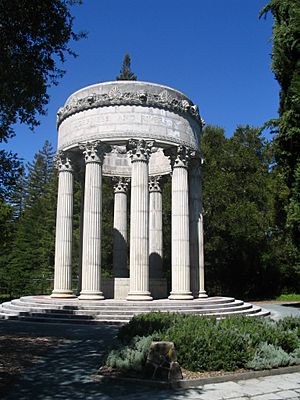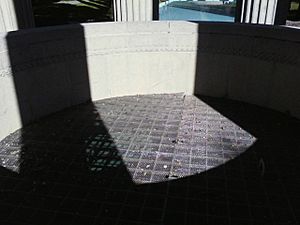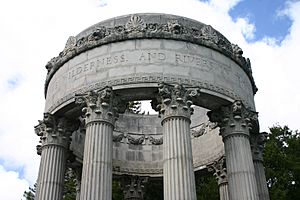Pulgas Water Temple facts for kids
The Pulgas Water Temple is a beautiful stone building located in Redwood City, California. It was designed by an architect named William G. Merchant. This special temple was built by the San Francisco Water Department to celebrate something big: the completion of the Hetch Hetchy Aqueduct in 1934. The temple sits right at the end of this aqueduct, which brings water from far away. Long ago, water used to flow right under the temple itself! But now, the water is sent to a nearby plant for cleaning before it goes anywhere else.
Contents
About the Temple Building
The Pulgas Water Temple you see today was finished in 1938. It replaced an earlier, temporary temple that was mostly made of wood. William Merchant designed this permanent temple, and Albert Bernasconi did the detailed carvings. The temple has a circle of tall, fancy columns called Corinthian columns. On top of these columns is a large stone ring with a special message carved into it. It says: "I give waters in the wilderness and rivers in the desert, to give drink to my people." This quote comes from an old book called Isaiah in the Bible. Around the temple, there's a calm pool of water that reflects the building, surrounded by cypress trees.
How Water Used to Flow Here
The cities of San Francisco and other places in the Bay Area get their drinking water from the Hetch Hetchy Reservoir. This reservoir is about 160 miles away! The water travels all that distance through the Hetch Hetchy Aqueduct. When the temple was first built, the water would flow over a small, curved waterfall right inside the Pulgas Water Temple. After that, it would continue for about 800 feet down a canal and into the Upper Crystal Springs Reservoir.
Why the Water Flow Changed
Over time, changes were made to how the water flows at the temple. A metal grate was put over the well inside the temple. This was done to stop people who might try to jump in and ride the water down the canal, which would be very dangerous! Since 2004, water no longer flows directly through the temple. Instead, it is sent to a nearby water treatment plant. At this plant, a chemical called chloramine, which was added earlier, is removed. This is important to prevent any harm to the environment when the water enters the reservoir. The water is then treated again with chloramine at another plant in San Bruno before it goes to homes.
The Temple's Historical Connection
The area where the Pulgas Water Temple stands is also a California Historical Landmark No. 92. This landmark remembers a very important event in California's past. It marks a place where the Spanish Portola expedition camped on November 11, 1769. The people on this expedition were the first Europeans to explore the inland parts of California. They were also the first to see the huge San Francisco Bay. The day before, while camping nearby, the expedition leaders decided to turn around and go back to San Diego. This meant they had to go back north to where they had crossed a place called Sweeney Ridge from the coast.
What "Pulgas" Means
The word Pulgas comes from the Spanish (and Portuguese) language, and it means "fleas." Early Spanish explorers in this area found many fleas! The name for this location comes from an old Spanish land grant called Rancho de las Pulgas.




